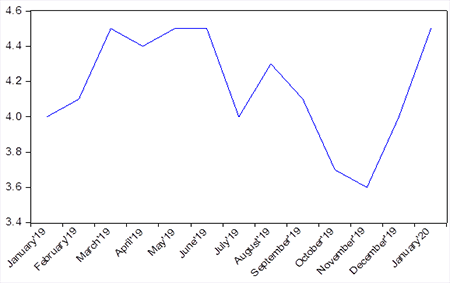The latest inflation statistics for January 2020 released by Stats SA on 19 February 2020 indicate that the annual (year-to-year) inflation increased by 0,5% to a rate of 4,5%.
In an earlier article [N1] at the beginning of February, the North-West University’s (NWU’s) Prof Danie Meyer and Roan Neethling, a doctoral student, predicted that the January inflation rate would rise from the December rate to between 4,2% to 4,4%. This prediction was based on the phenomena of stagflation and cost-push inflation.
“This prediction was correct, despite other trends such as low growth, low consumer spending and load shedding during January,” says Prof Meyer.
He says the statistics further indicate that utilities (for example municipal costs), food, housing, and transport were the main contributors to the high inflation rate for January.
Figure 1 illustrates the inflation rate (year-on-year), which indicates an upward trend from November 2019 to January 2020. This shows that the prices of goods and services are constantly increasing with a stagnating economy.
Prof Meyer says rising inflation usually corresponds to a growing economy, as the demand for goods and services increases due to higher spending capacity. However, in this case it is the total opposite.
“Inflation is increasing without adequate economic growth and this has a direct impact on the consumer’s spending capacity. The implication of the rising trend in the inflation rate is that the SARB will be under pressure to increase the interest rate at its next monetary policy meeting. Such a hike will have further negative impacts for the already struggling economy.”

Figure 1: Inflation rate year-on-year January 2019 to January 2020
